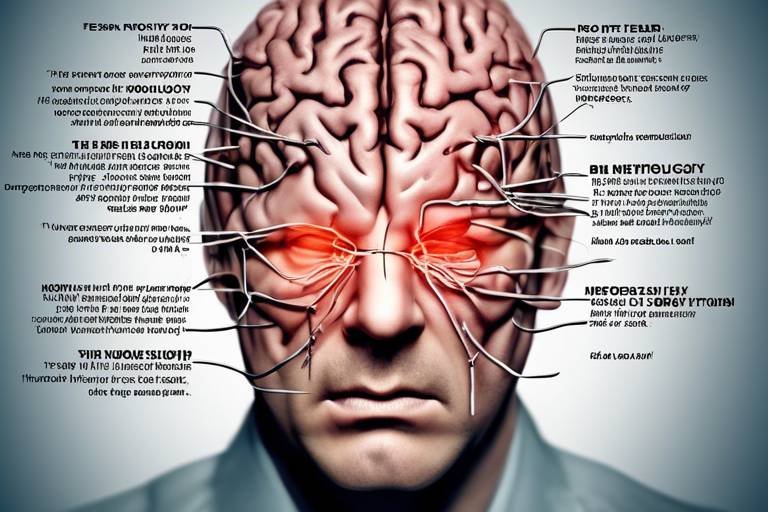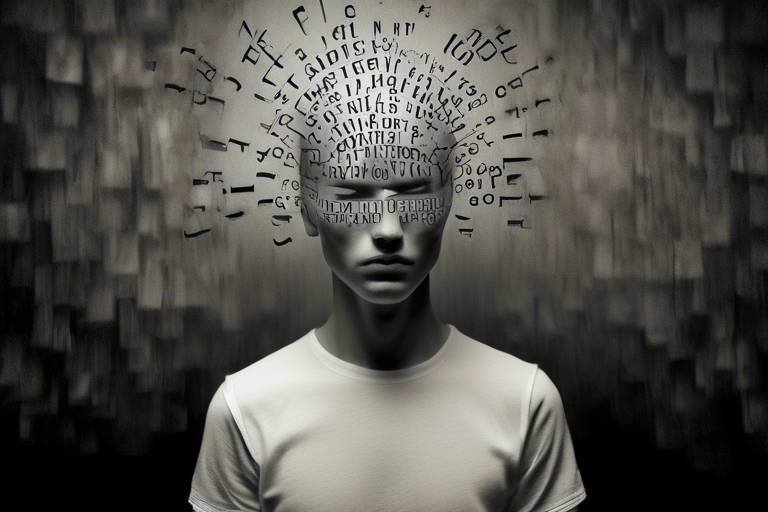Exploring the Mind-Brain Connection - Is there One?
The relationship between the mind and the brain has been a subject of intrigue and debate for centuries. Imagine your brain as a complex orchestra, with each neuron playing its own instrument, while your mind is the conductor, guiding the symphony of thoughts, emotions, and behaviors. But how do these two entities interact? Is there a clear connection, or are they merely parallel lines that never meet? This article delves into the intricate relationship between the mind and brain, examining scientific perspectives, historical context, and implications for mental health and personal development.
To truly grasp the mind-brain connection, we must first explore its historical perspective. Philosophers like René Descartes posited the idea of dualism, suggesting that the mind and body are separate entities. This view dominated for centuries, leading to a schism between scientific inquiry and philosophical thought. However, as science progressed, particularly in the realm of neuroscience, we began to see a shift. The brain, once considered merely a physical organ, is now recognized as a dynamic participant in our mental processes. This evolution has not only shaped our understanding of consciousness but also paved the way for modern psychological and neurological research.
In recent years, scientific research has provided groundbreaking insights into how brain activity correlates with mental states. For instance, advanced imaging techniques like functional MRI (fMRI) allow us to visualize brain activity in real-time. This means we can observe how different areas of the brain light up during various mental tasks, revealing a fascinating tapestry of connections between thoughts, emotions, and actions. It’s almost like watching a movie where the plot twists and turns, showcasing the intricate dance between the mind and the brain.
One of the pivotal elements in this connection is the role of neurotransmitters. These chemical messengers facilitate communication between neurons, influencing everything from mood to cognition. For instance, serotonin, often dubbed the "happy chemical," plays a crucial role in regulating our mood. When serotonin levels are balanced, we tend to feel more at ease and content. Conversely, a deficit can lead to mood disorders, highlighting how deeply intertwined our mental state is with brain chemistry.
Moreover, dopamine, another key neurotransmitter, is intricately linked to our reward systems. It drives our motivation and pleasure, acting as a powerful motivator for behavior. Think of it as the fuel that ignites our desire to pursue goals and enjoy life’s little pleasures. Understanding these neurotransmitters not only sheds light on the mind-brain connection but also provides valuable insights into mental health treatment.
As we delve deeper into the scientific realm, we encounter advanced brain imaging techniques that have revolutionized our understanding of this connection. Techniques like fMRI and PET scans allow researchers to visualize brain activity during various mental tasks, unveiling the physical underpinnings of our thoughts and emotions. This has opened new avenues for understanding complex mental health issues, providing a clearer picture of how our brain functions in relation to our mental states.
The implications of the mind-brain connection extend beyond mere curiosity; they have profound impacts on mental health. Conditions such as depression and anxiety are not just psychological experiences; they are deeply rooted in brain function. For example, studies have shown that depression can alter brain structure and function, emphasizing the need for a comprehensive approach to mental health that considers both the mind and the brain. By understanding these changes, we can develop more effective treatments that address the root causes of mental health issues.
In addition to the challenges posed by mental health conditions, there is also a silver lining—mindfulness and neuroplasticity. Mindfulness practices have been shown to promote neuroplasticity, the brain's remarkable ability to reorganize itself by forming new neural connections. This means that through practices like meditation, we can actively reshape our brain function and improve our mental health. Imagine your brain as a flexible piece of clay, capable of being molded into new shapes and forms through intentional practice.
Research has shown that meditation can lead to profound changes in brain structure and function, enhancing areas associated with emotional regulation and cognitive processing. It’s like giving your brain a workout, strengthening its ability to handle stress and improve overall well-being. Furthermore, integrating mindfulness into therapeutic practices can enhance treatment outcomes, offering a holistic approach to mental health that acknowledges the intricate connection between the mind and brain.
- What is the mind-brain connection? The mind-brain connection refers to the relationship between our mental processes and brain function, highlighting how thoughts and emotions are influenced by brain activity.
- How do neurotransmitters affect our mood? Neurotransmitters like serotonin and dopamine play crucial roles in regulating mood and motivation, influencing how we feel and behave.
- Can mindfulness practices really change the brain? Yes, mindfulness practices promote neuroplasticity, allowing the brain to reorganize and adapt, leading to improved mental health.

The Historical Perspective
Understanding the intricate relationship between the mind and brain requires a journey through history, where philosophical musings and scientific inquiries have danced together, shaping our current comprehension of consciousness and mental processes. From the ancient Greeks, who pondered the essence of the soul and mind, to modern neuroscientists unraveling the complexities of brain function, the evolution of thought on this connection is fascinating.
In ancient times, philosophers like Socrates and Plato laid the groundwork for exploring the mind's nature. They viewed the mind as an ethereal entity, separate from the physical body. Plato, for instance, believed in the concept of the tripartite soul, which divided the mind into three distinct parts: reason, spirit, and appetite. This philosophical perspective suggested a dualism that still influences discussions today.
Fast forward to the 17th century, when René Descartes famously declared, "I think, therefore I am." His dualistic view posited that the mind and body were separate but interacted through the pineal gland. This idea sparked debates that continue to this day, as scientists and philosophers grapple with the question of how a non-physical mind can influence a physical brain.
As we moved into the 19th century, the advent of psychology as a scientific discipline began to bridge the gap between philosophy and empirical study. Pioneers like Wilhelm Wundt and William James sought to understand mental processes through observation and experimentation. Their work laid the foundation for modern psychology, emphasizing the importance of studying the mind within the context of its biological underpinnings.
In the 20th century, the development of neuroscience revolutionized our understanding of the mind-brain connection. With technological advancements, researchers began to explore the brain's anatomy and functions, leading to groundbreaking discoveries about how specific brain regions correlate with various mental processes. This shift marked a significant departure from the purely philosophical inquiries of previous centuries.
Today, the mind-brain connection is studied through various lenses, including cognitive neuroscience, which combines principles from psychology and neuroscience to investigate how brain activity relates to cognitive functions. This interdisciplinary approach has provided insights into how thoughts, emotions, and behaviors are rooted in the brain's complex network of neurons.
In summary, the historical perspective on the mind-brain connection reveals a rich tapestry of thought, where philosophical inquiries paved the way for scientific exploration. As we continue to unravel the mysteries of consciousness, it's essential to appreciate the contributions of those who came before us, as their ideas laid the groundwork for our current understanding.
- What is the mind-brain connection?
The mind-brain connection refers to the relationship between mental processes (thoughts, emotions) and brain function, exploring how they influence each other.
- How has historical philosophy influenced modern neuroscience?
Historical philosophy introduced concepts about the mind and consciousness that have evolved into scientific inquiries, shaping our understanding of mental processes.
- What role do neurotransmitters play in the mind-brain connection?
Neurotransmitters facilitate communication between neurons and are crucial in regulating mood, cognition, and overall mental health.

Scientific Research
The exploration of the mind-brain connection has taken a significant leap forward thanks to recent advances in neuroscience. Researchers are now armed with cutting-edge tools that allow them to peer into the very workings of the brain, revealing how our thoughts, emotions, and behaviors are intricately linked to brain activity. Imagine being able to see your feelings play out on a screen as brain waves dance to the rhythm of your thoughts! This thrilling intersection of science and psychology not only deepens our understanding but also opens doors to improved mental health treatments.
One of the most fascinating aspects of this research is the correlation between specific brain activities and mental states. Studies using functional magnetic resonance imaging (fMRI) and positron emission tomography (PET) scans have demonstrated that different areas of the brain light up during various cognitive tasks. For instance, when individuals engage in problem-solving, regions associated with critical thinking and logic become highly active. Conversely, when someone is reminiscing about a cherished memory, areas linked to emotional processing come to life. This dynamic interplay illustrates the profound relationship between our mental experiences and brain function.
Moreover, the role of neurotransmitters—chemical messengers in the brain—cannot be overstated when discussing the mind-brain connection. These substances are like the conductors of an orchestra, ensuring that messages are transmitted efficiently between neurons. For example, serotonin and dopamine are two key players that not only influence mood and motivation but also serve as vital links between our emotional states and brain health. The following table summarizes the primary neurotransmitters and their associated functions:
| Neurotransmitter | Function |
|---|---|
| Serotonin | Regulates mood, appetite, and sleep |
| Dopamine | Influences motivation, pleasure, and reward |
| Norepinephrine | Affects attention and responding actions |
| GABA | Inhibits nerve transmission in the brain |
As we delve deeper into the science, it becomes clear that understanding these neurotransmitters is crucial for grasping how mental states can manifest physically in the brain. For instance, an imbalance in serotonin levels is often linked to mood disorders such as depression, while dopamine dysregulation can lead to issues with motivation and pleasure. This intricate web of connections highlights the importance of a holistic approach to mental health, where both the mind and brain are treated as interconnected entities.
In summary, the scientific research surrounding the mind-brain connection is not just a dry academic pursuit; it is a vibrant field that has the potential to change lives. By unraveling the mysteries of how our mind influences our brain and vice versa, we are paving the way for innovative treatments and a better understanding of what it means to be human. So next time you ponder your thoughts or emotions, remember that there's a fascinating world of neurons and neurotransmitters at play, working tirelessly to shape your experiences.

The Role of Neurotransmitters
Neurotransmitters are the unsung heroes of our brain's communication network. They act as the messengers that relay information between neurons, influencing everything from our mood to our cognitive abilities. Imagine them as tiny delivery trucks, carrying vital cargo across a complex highway of neural pathways. Without these little vehicles, our brain would be a chaotic mess, unable to function properly.
These chemical messengers are crucial for the mind-brain connection, as they help translate our thoughts and feelings into physical reactions. For instance, when you're feeling happy, it's often due to the release of neurotransmitters like serotonin and dopamine. Conversely, when stress or anxiety hits, neurotransmitters can be thrown off balance, leading to a cascade of emotional and physical symptoms.
To better understand the significance of neurotransmitters, let's take a closer look at a few key players:
- Serotonin: Often dubbed the "feel-good" neurotransmitter, serotonin is pivotal in regulating mood, sleep, and appetite. Low levels of serotonin are linked to mood disorders, which can severely impact our mental health.
- Dopamine: This neurotransmitter is associated with the brain's reward system. It plays a significant role in motivation, pleasure, and even motor control. An imbalance in dopamine levels can lead to conditions such as addiction or Parkinson's disease.
- Norepinephrine: This neurotransmitter helps regulate arousal and alertness. It's particularly important during stressful situations, as it prepares the body for a 'fight or flight' response.
Each of these neurotransmitters interacts in intricate ways, creating a complex web of chemical reactions that underpin our mental states. For example, a dip in serotonin can lead to increased anxiety, which in turn affects dopamine levels, creating a feedback loop that can spiral into more severe mental health issues.
Understanding the role of neurotransmitters not only sheds light on the mind-brain connection but also opens doors for potential therapeutic interventions. By targeting specific neurotransmitter systems, therapists and medical professionals can develop treatments that help restore balance and improve mental well-being.
In conclusion, neurotransmitters are essential players in the dance between the mind and the brain. They influence our emotions, thoughts, and behaviors, making them a focal point for anyone looking to understand the complexities of mental health. As we continue to explore this fascinating connection, we uncover the profound implications for personal development and therapeutic practices.
- What are neurotransmitters? Neurotransmitters are chemical messengers that transmit signals between neurons in the brain, influencing mood, cognition, and behavior.
- How do neurotransmitters affect mental health? Imbalances in neurotransmitter levels can lead to various mental health disorders, including depression and anxiety.
- Can neurotransmitters be regulated through diet? Yes, certain foods can influence neurotransmitter production. For example, foods rich in omega-3 fatty acids can boost serotonin levels.

Serotonin and Mood Regulation
Serotonin, often dubbed the "feel-good" neurotransmitter, plays a pivotal role in regulating our mood and emotional well-being. Imagine serotonin as a conductor of an orchestra, harmonizing various aspects of our mental state. When serotonin levels are balanced, we experience feelings of happiness, calmness, and overall contentment. However, when these levels dip, the music can turn discordant, leading to feelings of sadness or anxiety.
Research has shown that serotonin is not only crucial for mood regulation but also influences a range of bodily functions, including sleep, appetite, and digestion. This multifaceted role makes it essential for maintaining not just mental health but physical health as well. For instance, low serotonin levels have been linked to various mood disorders such as depression and anxiety. Understanding this connection can provide insights into why some individuals experience mood swings or prolonged periods of sadness.
Interestingly, serotonin's influence extends beyond the brain. About 90% of the body's serotonin is produced in the gastrointestinal tract, which raises the question: how does our gut health affect our mental health? This connection emphasizes the importance of a balanced diet rich in nutrients that support serotonin production. Foods such as nuts, seeds, eggs, and fish are excellent sources of the amino acid tryptophan, which is a precursor to serotonin. Therefore, a healthy diet can be a powerful ally in managing mood and emotional stability.
Moreover, lifestyle factors such as physical activity and exposure to sunlight can significantly impact serotonin levels. Regular exercise has been shown to boost serotonin production, leading to improved mood and reduced symptoms of depression. Similarly, natural sunlight exposure helps increase serotonin levels, which is why many people feel happier on sunny days. It's fascinating how our environment and lifestyle choices can profoundly affect our brain chemistry.
In summary, serotonin plays a crucial role in mood regulation, acting as a bridge between our mental and physical health. By understanding its functions and the factors that influence its levels, we can take proactive steps to enhance our well-being. Whether it's through dietary choices, exercise, or simply soaking up some sun, there are many ways to support our serotonin levels and, in turn, our emotional health.
- What is serotonin? Serotonin is a neurotransmitter that helps regulate mood, sleep, appetite, and digestion.
- How does serotonin affect mood? Balanced serotonin levels contribute to feelings of happiness and well-being, while low levels can lead to mood disorders.
- Can diet influence serotonin levels? Yes, a diet rich in tryptophan-containing foods can help boost serotonin production.
- What lifestyle changes can improve serotonin levels? Regular exercise, exposure to sunlight, and a healthy diet can all enhance serotonin levels and improve mood.

Dopamine and Reward Systems
Dopamine is often referred to as the "feel-good" neurotransmitter, and for good reason! It plays a pivotal role in our brain's reward system, influencing not just how we feel pleasure but also how we learn and make decisions. When we engage in activities that bring us joy—like eating a delicious meal, winning a game, or receiving praise—dopamine is released, creating a sense of satisfaction and reinforcing those behaviors. This process is akin to a reward system in a video game, where each achievement unlocks new levels of enjoyment and motivation.
But what happens when this system is disrupted? Conditions such as addiction, depression, and certain mental health disorders can lead to an imbalance in dopamine levels, affecting our motivation and emotional well-being. For instance, in addiction, the brain becomes wired to seek out the substance or behavior that triggers dopamine release, often at the expense of healthier activities. This creates a cycle that can be incredibly difficult to break, as the brain begins to prioritize the short-term pleasure of the addictive behavior over long-term fulfillment.
To understand the complexity of dopamine's role, it's essential to recognize its interaction with various brain regions. The mesolimbic pathway, a key component of the brain's reward circuitry, is particularly important. This pathway connects several brain areas, including the ventral tegmental area (VTA) and the nucleus accumbens, facilitating the release of dopamine during rewarding experiences. The table below summarizes the key functions and impacts of dopamine in the brain:
| Function | Impact on Behavior |
|---|---|
| Reward Processing | Increases motivation to pursue rewarding activities |
| Learning | Enhances memory formation related to rewards |
| Movement Regulation | Plays a role in coordinating voluntary movement |
| Emotional Response | Affects mood and emotional regulation |
Moreover, dopamine isn't just about pleasure; it's also intricately linked to our decision-making processes. When faced with choices, our brain evaluates potential rewards and risks, guided by dopamine levels. This can explain why some individuals may take risks that seem irrational to others; their brain's reward system may be calibrated differently, leading them to pursue immediate gratification over long-term benefits.
In essence, understanding dopamine and its reward systems provides invaluable insights into human behavior. It highlights the delicate balance our brains maintain between seeking pleasure and making rational decisions. As we continue to explore this fascinating relationship, we can better appreciate the complexities of our mental states and the neurological foundations that drive our actions.
- What is dopamine? Dopamine is a neurotransmitter that plays a crucial role in the brain's reward system, influencing pleasure, motivation, and learning.
- How does dopamine affect mental health? Imbalances in dopamine levels can lead to various mental health issues, including addiction and depression, impacting motivation and emotional well-being.
- Can dopamine levels be increased naturally? Yes! Engaging in physical activities, practicing mindfulness, and enjoying hobbies can help boost dopamine levels naturally.
- What are the signs of low dopamine levels? Symptoms may include fatigue, lack of motivation, mood swings, and difficulty concentrating.

Brain Imaging Techniques
Brain imaging techniques have revolutionized the way we understand the intricate relationship between the mind and brain. These advanced technologies allow scientists to observe brain activity in real-time, providing invaluable insights into how our thoughts, emotions, and behaviors are linked to specific neural patterns. Imagine being able to see the brain light up like a city at night, with different regions glowing in response to various stimuli or tasks. This is precisely what techniques like functional Magnetic Resonance Imaging (fMRI) and Positron Emission Tomography (PET) enable us to do.
Functional MRI, or fMRI, is one of the most commonly used brain imaging techniques today. It measures brain activity by detecting changes in blood flow, effectively allowing researchers to visualize which parts of the brain are engaged during specific mental tasks. For instance, when someone is asked to solve a math problem, the fMRI scan can show increased activity in the areas responsible for numerical processing. This dynamic imaging capability has led to groundbreaking discoveries in understanding cognitive functions and emotional responses.
On the other hand, Positron Emission Tomography (PET) provides a different perspective by using radioactive tracers to visualize metabolic processes in the brain. This technique is particularly useful for studying the brain's biochemical activity and can reveal how different substances, such as neurotransmitters, are distributed throughout the brain. By combining the insights from both fMRI and PET scans, researchers can create a more comprehensive picture of how our mental states are reflected in brain activity.
Moreover, the advancements in brain imaging have also paved the way for exploring mental health disorders. For example, studies utilizing these imaging techniques have shown distinct patterns in the brains of individuals suffering from conditions like depression and anxiety. By understanding these patterns, scientists can develop targeted therapies and interventions. Below is a table summarizing the key differences between fMRI and PET scans:
| Technique | Method | Uses | Advantages |
|---|---|---|---|
| fMRI | Measures blood flow changes | Cognitive tasks, emotional responses | High spatial resolution, real-time imaging |
| PET | Uses radioactive tracers | Metabolic processes, neurotransmitter activity | Useful for studying biochemical activity |
In conclusion, brain imaging techniques are not just tools for researchers; they are windows into the workings of our minds. By employing these sophisticated methods, scientists can unravel the complexities of the mind-brain connection, ultimately leading to improved mental health treatments and a deeper understanding of human consciousness.
- What is the primary purpose of brain imaging techniques?
Brain imaging techniques are primarily used to visualize and understand brain activity, helping researchers explore the relationship between mental states and neural processes. - How does fMRI differ from PET scans?
fMRI measures changes in blood flow to assess brain activity, while PET scans utilize radioactive tracers to visualize metabolic processes within the brain. - Can brain imaging help with mental health treatments?
Yes, brain imaging can identify patterns associated with mental health disorders, guiding the development of targeted therapies and interventions.

The Impact of Mental Health
Mental health is not just a buzzword; it's a crucial aspect of our overall well-being that profoundly influences how we think, feel, and act. When we consider the mind-brain connection, it becomes clear that mental health conditions can significantly alter brain function and structure. Imagine your brain as a garden; when well-tended, it flourishes, but when neglected, weeds of anxiety, depression, and other disorders can take root, choking the life out of it.
Research has shown that mental health issues can lead to observable changes in brain anatomy and functionality. For instance, conditions like depression often result in reduced volume in key brain areas such as the hippocampus, which plays a critical role in memory and emotional regulation. This highlights the importance of understanding mental health not just as an emotional or psychological issue, but as one that has tangible effects on the brain's physical structure.
Moreover, the interplay between mental health and brain function can be quite complex. Take anxiety disorders, for example. These conditions can cause hyperactivity in the amygdala, the brain's fear center, leading to heightened stress responses. This hyperactivity creates a vicious cycle: as anxiety escalates, it further impacts the brain's ability to regulate emotions, leading to even greater feelings of fear and panic.
Understanding these connections is essential for effective treatment and therapy. Here are some key points to consider:
- Holistic Approaches: Mental health treatment must address both psychological and physiological aspects. Therapy, medication, and lifestyle changes work best when integrated.
- Early Intervention: Recognizing signs of mental health issues early can prevent more severe brain changes and improve long-term outcomes.
- Education: Increasing awareness about the impact of mental health on brain function can empower individuals to seek help sooner.
In conclusion, the impact of mental health on brain function is profound and multifaceted. By acknowledging this connection, we can foster a more comprehensive approach to mental health care, ultimately leading to better outcomes for individuals struggling with these challenges.
1. How does mental health affect brain structure?
Mental health issues can lead to changes in brain volume and functionality, particularly in areas responsible for memory and emotional regulation.
2. Can improving mental health reverse brain changes?
Yes, engaging in therapy, medication, and lifestyle changes can help restore brain function and structure over time.
3. What role does therapy play in mental health?
Therapy can provide coping strategies, emotional support, and tools for managing mental health conditions, ultimately benefiting brain health.
4. How can I improve my mental health?
Practices such as mindfulness, regular exercise, and seeking professional help can significantly enhance mental health and, by extension, brain function.

Depression and Brain Changes
Depression isn't just a fleeting feeling of sadness; it’s a complex mental health disorder that can fundamentally alter the brain's structure and function. Imagine your brain as a bustling city, where different neighborhoods represent various functions and emotions. When depression strikes, it's like a sudden storm that disrupts traffic, causing chaos in communication between these neighborhoods. Research has shown that individuals with depression often experience significant changes in key brain areas, including the prefrontal cortex, amygdala, and hippocampus.
The prefrontal cortex, responsible for decision-making and regulating emotions, tends to shrink in size during depressive episodes. This shrinkage can lead to difficulties in thinking clearly and making rational choices. Meanwhile, the amygdala, which processes emotions such as fear and pleasure, often becomes hyperactive. This increased activity can result in heightened emotions and a persistent sense of unease or anxiety, making it feel like you’re stuck in a never-ending loop of negativity.
Furthermore, the hippocampus, essential for memory formation, is also impacted. Studies indicate that chronic depression can lead to a decrease in the volume of the hippocampus, which may explain why many individuals with depression struggle with memory and concentration. It’s as if the city’s library is being closed off, making it harder to recall important information or past experiences.
To illustrate these changes, let’s take a look at the following table that summarizes the effects of depression on brain structure:
| Brain Region | Function | Impact of Depression |
|---|---|---|
| Prefrontal Cortex | Decision-making, emotional regulation | Shrinks in size, leading to impaired judgment |
| Amygdala | Emotion processing | Becomes hyperactive, causing heightened anxiety |
| Hippocampus | Memory formation | Decreases in volume, affecting memory and concentration |
Understanding these brain changes is crucial for developing effective treatment strategies. With the right interventions, such as therapy, medication, or lifestyle changes, it's possible to support brain health and promote recovery. Just like a city can rebuild after a storm, the brain has the remarkable ability to recover and adapt through a process known as neuroplasticity. This means that with the right tools and support, individuals can regain control over their mental health and restore balance to their emotional landscape.
In conclusion, recognizing the intricate relationship between depression and brain changes not only sheds light on the complexity of this condition but also emphasizes the importance of seeking help. If you or someone you know is struggling with depression, remember that understanding the science behind it can pave the way for healing and recovery.
- What are the common symptoms of depression?
Common symptoms include persistent sadness, loss of interest in activities, fatigue, and changes in sleep or appetite. - How can I support someone with depression?
Being there to listen, encouraging them to seek professional help, and offering to assist with daily tasks can be beneficial. - Is depression treatable?
Yes, depression is treatable through various methods including therapy, medication, and lifestyle changes.

Anxiety Disorders and Neurobiology
Anxiety disorders are not just a state of mind; they represent a complex interplay between our thoughts, emotions, and the biological mechanisms within our brains. When we experience anxiety, it's as if our brain is caught in a storm, with certain regions lighting up like fireworks. Research shows that anxiety disorders are often linked to alterations in brain structures and functions, particularly in areas responsible for processing fear and stress. Understanding this neurobiological basis is crucial for developing effective treatments and interventions.
One of the primary regions implicated in anxiety is the amygdala. This almond-shaped structure is a key player in our emotional responses, especially fear. In individuals with anxiety disorders, the amygdala may become hyperactive, leading to exaggerated responses to perceived threats. Imagine your brain as a security system; when it's functioning normally, it alerts you to genuine dangers. However, in anxiety disorders, the system can become overly sensitive, triggering alarms even when there is no real threat.
Additionally, the prefrontal cortex, responsible for higher-order thinking and decision-making, often shows reduced activity in those suffering from anxiety. This can lead to impaired judgment and difficulty in regulating emotional responses. Think of the prefrontal cortex as the wise advisor in your brain; when it's not functioning optimally, it can struggle to calm the storm created by the amygdala.
Moreover, the connection between neurotransmitters and anxiety cannot be overlooked. Neurotransmitters such as serotonin, dopamine, and gamma-aminobutyric acid (GABA) play significant roles in mood regulation and anxiety levels. For instance, low levels of serotonin have been linked to increased anxiety, while GABA, which has a calming effect, helps to reduce excitability in the brain. Here’s a quick overview of how these neurotransmitters impact anxiety:
| Neurotransmitter | Role in Anxiety |
|---|---|
| Serotonin | Low levels are associated with increased anxiety and mood disorders. |
| Dopamine | Influences motivation and pleasure; imbalances can affect emotional responses. |
| GABA | Acts as a calming agent, reducing neuronal excitability and anxiety levels. |
In summary, anxiety disorders are deeply rooted in neurobiological processes. The interaction between the amygdala, prefrontal cortex, and various neurotransmitters creates a complex landscape that can lead to the overwhelming feelings associated with anxiety. Understanding these mechanisms not only sheds light on the nature of anxiety disorders but also opens doors to more targeted and effective treatment options.
As we explore the mind-brain connection further, it becomes clear that addressing anxiety requires a holistic approach that considers both the psychological and biological dimensions. This understanding is vital for anyone looking to navigate the turbulent waters of anxiety, whether through therapy, medication, or mindfulness practices.
- What are anxiety disorders? Anxiety disorders are mental health conditions characterized by excessive fear or worry that can interfere with daily activities.
- How do anxiety disorders affect the brain? They can lead to changes in brain structure and function, particularly in areas related to fear processing and emotional regulation.
- What treatments are available for anxiety disorders? Treatments can include therapy, medication, and lifestyle changes such as mindfulness and exercise.
- Can mindfulness help with anxiety? Yes, mindfulness practices can promote neuroplasticity and help regulate emotions, potentially reducing anxiety symptoms.

Mindfulness and Neuroplasticity
In recent years, the concept of mindfulness has gained significant traction, not just as a trendy buzzword but as a powerful tool for mental well-being. But what exactly is mindfulness? At its core, mindfulness involves being fully present in the moment, aware of your thoughts, feelings, and surroundings without judgment. This practice has profound implications for our brains, particularly in the realm of neuroplasticity—the brain's remarkable ability to reorganize itself by forming new neural connections throughout life.
Imagine your brain as a bustling city, with roads representing neural pathways. Over time, some roads may become congested or even fall into disrepair. Mindfulness acts as a construction crew, paving new roads and repairing old ones, making it easier for information to travel efficiently. This is where the magic happens: through consistent mindfulness practice, individuals can actually reshape their brain's structure and function.
Research has shown that engaging in mindfulness meditation can lead to changes in brain regions associated with emotion regulation, memory, and self-awareness. For instance, studies using brain imaging techniques reveal that regular mindfulness practitioners often exhibit increased gray matter density in areas of the brain linked to emotional regulation, such as the prefrontal cortex, and decreased activity in the amygdala, which is responsible for processing fear and anxiety.
Let’s take a closer look at some of the specific benefits of mindfulness on neuroplasticity:
- Enhanced Attention: Mindfulness practices can improve focus and concentration, allowing individuals to better manage distractions.
- Emotional Resilience: By fostering a non-judgmental awareness of thoughts and feelings, mindfulness helps individuals respond to emotional challenges more effectively.
- Stress Reduction: Regular mindfulness practice has been shown to lower levels of the stress hormone cortisol, promoting a sense of calm and well-being.
Furthermore, the implications of mindfulness extend beyond individual benefits; they can also influence our overall mental health landscape. For example, integrating mindfulness into therapeutic practices can lead to more effective treatment outcomes for conditions like anxiety and depression. Therapists are increasingly incorporating mindfulness-based approaches, such as Mindfulness-Based Stress Reduction (MBSR) and Mindfulness-Based Cognitive Therapy (MBCT), into their sessions, creating a holistic approach that addresses both the mind and the brain.
In summary, mindfulness is not just a fleeting trend; it is a scientifically-backed practice that promotes neuroplasticity and enhances mental health. By embracing mindfulness, individuals can pave the way for a healthier mind and a more resilient brain.
- What is mindfulness? Mindfulness is the practice of being fully present and engaged in the moment, aware of your thoughts and feelings without judgment.
- How does mindfulness affect the brain? Mindfulness can lead to changes in brain structure and function, particularly in areas related to emotion regulation and self-awareness.
- Can mindfulness help with mental health issues? Yes, mindfulness practices have been shown to reduce symptoms of anxiety and depression and improve overall mental well-being.

The Benefits of Meditation
Meditation is more than just a trendy wellness practice; it’s a powerful tool that can reshape our minds and enhance our overall well-being. Imagine your brain as a bustling city, filled with traffic and noise. Now, picture meditation as a calming rain that washes away the chaos, allowing for clearer pathways and smoother connections. This practice has been shown to bring about profound changes in both mental and physical health, making it a vital component of personal development.
Research has demonstrated that regular meditation can lead to structural changes in the brain, particularly in areas associated with emotional regulation, attention, and self-awareness. For instance, studies using brain imaging techniques have revealed that meditation can increase the thickness of the prefrontal cortex, the area responsible for higher-order thinking and decision-making. This is akin to upgrading your computer's processor to handle more complex tasks efficiently.
Furthermore, meditation has been linked to significant reductions in stress and anxiety levels. It acts as a natural antidote to the relentless pressures of modern life. Just think about it: when you meditate, you train your mind to focus and remain present, which can help diminish the incessant chatter of worries and fears. A study conducted by neuroscientists found that participants who engaged in mindfulness meditation exhibited lower levels of the stress hormone cortisol, leading to a more balanced emotional state.
Another remarkable benefit of meditation is its ability to enhance emotional well-being. By fostering a deeper connection with oneself, individuals often report feeling more compassionate and empathetic towards others. This can create a ripple effect, improving relationships and social interactions. It’s like nurturing a garden; when you cultivate your inner self, the beauty of your emotional landscape flourishes.
To give you a clearer picture, here’s a quick overview of some key benefits of meditation:
- Improved Focus: Regular practice enhances attention span and concentration.
- Better Sleep: Meditation can help calm the mind, leading to more restful sleep.
- Enhanced Self-Awareness: It encourages a deeper understanding of oneself and one's thought patterns.
- Reduced Symptoms of Anxiety and Depression: Many find relief from mental health issues through consistent meditation.
Additionally, meditation promotes neuroplasticity, the brain's remarkable ability to reorganize itself by forming new neural connections. This means that with consistent practice, you can literally change the way your brain functions. It’s like renovating a house; you can knock down walls and create new spaces that better serve your needs.
Incorporating meditation into your daily routine doesn’t have to be daunting. Even a few minutes a day can yield significant benefits. Whether you choose to sit in silence, practice guided meditation, or engage in mindful breathing, the key is consistency. Over time, you’ll likely notice a shift in how you respond to stressors and an increase in your overall sense of peace.
In summary, the benefits of meditation extend far beyond the moment of practice. They ripple out into every aspect of life, creating a more harmonious existence. As we continue to explore the mind-brain connection, meditation stands out as a beacon of hope for enhancing mental health and personal growth.
Q: How long should I meditate each day to see benefits?
A: Even a few minutes of meditation each day can be beneficial. Aim for at least 5-10 minutes to start, gradually increasing the duration as you become more comfortable.
Q: Do I need to sit cross-legged to meditate?
A: No, you can meditate in any comfortable position. The key is to find a posture that allows you to relax and focus.
Q: Can meditation help with physical health issues?
A: Yes, research suggests that meditation can have positive effects on physical health, including reducing blood pressure, improving immune function, and alleviating chronic pain.
Q: Is there a specific type of meditation I should practice?
A: There are various types of meditation, such as mindfulness, transcendental, and loving-kindness. Experiment with different styles to find what resonates best with you.

Therapeutic Applications
The understanding of the mind-brain connection has opened up exciting avenues for . With a deeper insight into how our thoughts, emotions, and behaviors are intertwined with brain function, therapists and mental health professionals are now better equipped to tailor their approaches to individual needs. Imagine if you could not only talk about your feelings but also engage in practices that physically reshape your brain's structure and function. Sounds revolutionary, right? Well, that’s precisely what integrating mindfulness and other therapeutic techniques can achieve.
One of the most compelling aspects of this connection is the role of mindfulness in therapy. Mindfulness practices encourage individuals to focus on the present moment, which can significantly reduce stress and anxiety. When we practice mindfulness, we are not just calming our minds; we are also instigating changes in our brain's neural pathways. Studies have shown that consistent mindfulness practice can lead to increased gray matter density in areas of the brain associated with emotional regulation and self-referential thought.
Moreover, integrating mindfulness into therapy can enhance treatment outcomes. For instance, Cognitive Behavioral Therapy (CBT) can be greatly enriched by mindfulness techniques. By combining these approaches, therapists can help clients develop a more profound awareness of their thought patterns and emotional responses. This dual approach not only addresses the symptoms but also the underlying cognitive processes, making it a holistic treatment option.
To illustrate the impact of mindfulness in therapeutic settings, consider the following table that summarizes key findings from recent studies:
| Study | Key Findings | Implications for Therapy |
|---|---|---|
| Davidson et al. (2003) | Increased activation in left prefrontal cortex after mindfulness training | Potential for improved emotional regulation |
| Holzel et al. (2011) | Increased cortical thickness in areas related to attention and sensory processing | Enhanced cognitive functions and focus |
| Zeidan et al. (2010) | Improved attention and reduced pain perception post-mindfulness practice | Application in pain management therapies |
Additionally, therapeutic applications extend beyond traditional talk therapy. Techniques such as meditation, guided imagery, and even yoga can serve as complementary practices that enhance mental health. These methods promote neuroplasticity, allowing the brain to adapt and rewire itself in response to new experiences and learning. For instance, yoga combines physical movement, breath control, and meditation, which can lead to significant reductions in anxiety and depressive symptoms. In a way, it's like giving your brain a workout, helping it become more resilient over time.
Furthermore, the integration of technology in therapy is also on the rise. With the advent of apps designed for mindfulness and meditation, individuals can access therapeutic practices at their convenience. These digital tools can serve as an adjunct to traditional therapy, providing users with resources to practice mindfulness and self-regulation techniques in their daily lives. This accessibility is crucial, especially for those who may feel intimidated by conventional therapy settings.
In conclusion, the therapeutic applications of understanding the mind-brain connection are vast and varied. By embracing mindfulness and integrating it into therapy, mental health professionals can offer more comprehensive and effective treatment options. The mind and brain are not separate entities; they are intricately linked, and recognizing this connection paves the way for innovative approaches to mental health care.
- What is the mind-brain connection? The mind-brain connection refers to the relationship between our mental processes (thoughts, emotions) and the physical functioning of the brain.
- How can mindfulness improve mental health? Mindfulness practices can reduce stress and anxiety, enhance emotional regulation, and promote overall well-being by changing brain structure and function.
- Are there specific therapies that utilize the mind-brain connection? Yes, therapies like Cognitive Behavioral Therapy (CBT) and mindfulness-based stress reduction (MBSR) leverage this connection to enhance treatment outcomes.
Frequently Asked Questions
- What is the mind-brain connection?
The mind-brain connection refers to the intricate relationship between our mental processes (thoughts, emotions, consciousness) and the physical structure and function of the brain. It's a fascinating area of study that seeks to understand how our thoughts and feelings are rooted in our brain's activity.
- How has the historical perspective shaped our understanding of the mind-brain connection?
Throughout history, philosophers and scientists have debated the nature of consciousness and how it relates to the brain. These discussions have evolved, leading to a more nuanced understanding that incorporates both philosophical insights and scientific research, ultimately shaping our current views on mental processes.
- What role do neurotransmitters play in the mind-brain relationship?
Neurotransmitters are chemical messengers that facilitate communication between neurons in the brain. They significantly influence our mood, cognition, and overall mental health. For instance, serotonin is linked to feelings of well-being, while dopamine is associated with motivation and pleasure.
- How do brain imaging techniques help us understand the mind-brain connection?
Advancements in brain imaging technologies, such as fMRI and PET scans, allow researchers to visualize brain activity during various mental tasks. These techniques provide valuable insights into how different areas of the brain are activated in response to thoughts and emotions, enhancing our understanding of the mind-brain connection.
- What impact do mental health conditions have on brain function?
Mental health conditions like depression and anxiety can lead to significant changes in brain structure and function. Understanding these effects is crucial for developing effective treatments and therapies that address both the mind and the brain.
- How does mindfulness practice influence neuroplasticity?
Mindfulness practices have been shown to promote neuroplasticity, which is the brain's ability to reorganize itself by forming new neural connections. This means that engaging in mindfulness can actually reshape brain function, leading to improved mental health and overall well-being.
- What are the benefits of meditation on the mind-brain connection?
Meditation has profound effects on brain structure and function, including increased gray matter density in areas associated with memory, emotional regulation, and self-awareness. These changes highlight how meditation can enhance our understanding of the mind-brain connection and improve mental health.
- How can understanding the mind-brain connection inform therapeutic practices?
By integrating knowledge of the mind-brain connection into therapeutic practices, mental health professionals can develop more effective treatment strategies. For instance, incorporating mindfulness techniques into therapy can enhance treatment outcomes by promoting awareness and emotional regulation.



















